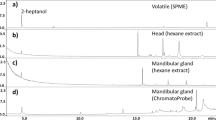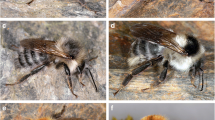Abstract
Diastereomers of the spiroacetal, 2,8-dimethyl-1,7-dioxaspiro [5.5]undecane, represent main components of the cephalic secretion from males of the solitary bee,Andrena wilkella. The major compound proved to be of high enantiomeric purity, showing (2S,6R,8S) configuration. Only the naturally occurring enantiomer attracted patrolling males in the field; its antipode was behaviorally inactive and in a racemic mixture did not inhibit response. The (E,Z) diastereomers were also found to be almost inactive. EAG studies gave the same result as the behavioral tests. The biological function of the spiroacetal is discussed in view of the evolution of the mating behavior inA. wilkella.
Similar content being viewed by others
References
Alcock, J. 1984. Convergent evolution in perching and patrolling site preferences of some hilltopping insects of the Sonoran desert.Southwest. Nat. 29:475–480.
Alcock, J. 1987. Leks and hilltopping in insects.J. Nat. Hist. 21:319–328.
Alcock, J., Barrows, E.M., Gordh, G., Hubbard, L.J., Kirkendall, L., Pyle, D.W., Ponder, T.L., andZalom, F.G. 1978. The ecology and evolution of male reproductive behaviour in the bees and wasps.Zool. J. Linn. Soc. 64:293–326.
Attygalle, A.B., andMorgan, E.D. 1984. Chemicals from the glands of ants.Chem. Soc. Rev. 13:245–278.
Attygalle, A.B., Morgan, E.D., Evershed, R.P., andRowland, S.J. 1983. Comparison of three derivatives for the enantiomeric separation of chiral alcohols and for the absolute configuration ofMyrmica ant 3-octanol.J. Chromatogr. 260:411–417.
Baker, R., Howse, H.R., Jones, O.T., Reith, W., andFrancke, W. 1980. Identification and synthesis of the major sex pheromone of the olive flyDacus oleae.J. Chem. Soc., Chem. Commun. 1980:52–53.
Bergström, G., Tengö, J., Reith, W., andFrancke, W. 1982. Multicomponent mandibular gland secretions in three species ofAndrena bees (Hym., Apoidea).Z. Naturforsch. 37c:1124–1129.
Blum, M.S. 1981. Chemical Defenses of Arthropods. Academic Press, New York.
Borden, J.H., Chong, L., McLean, J.A., Slessor, K.N., andMori, K. 1976. Synergistic response to enantiomers of the aggregation pheromone sulcatol.Science 192:894–896.
Borden, J.H., Handley, J.R., McLean, J.A., Silverstein, R.M., Chong, L., Slessor, K.N., Johnston, B.D., andSchuler, H.R. 1980. Enantiomer-based specificity in pheromone communication by two sympatricGnathotrichus species (Coleoptera: Scolytidae).J. Chem. Ecol. 6:445–455.
Borg-Karlson, A.-K., Ågren, L., Dobson, H., andBergström, G. 1988. Identification and electroantennographic activity of sex-specific geranyl esters in an abdominal gland of femaleAgriotes obscurus (L.) andA. lineatus (L.) (Coleoptera, Elateridae).Experientia 44:531–534.
Davies, N.W., andMadden, J.L. 1985. Mandibular gland secretions of two parasitoid wasps (Hymenoptera: Ichneumonidae).J. Chem. Ecol. 11:1115–1127.
Dettner, K., andSchwinger, G. 1986. Volatiles from the defensive secretion of two rove beetle species (Coleoptera: Staphylinidae).Z. Naturforsch. 41c:366–368.
Eickwort, G.C., andGinsberg, H.S. 1980. Foraging and mating behavior in Apoidea.Annu. Rev. Entomol. 25:421–446.
Engels, E., Engels, W., Schröder, W., andFrancke, W. 1987. Intranidal worker reactions to volatile compounds identified from cephalic secretions in the stingless bee,Scaptotrigona postica (Hymenoptera, Meliponidae).J. Chem. Ecol. 13:371–386.
Francke, W. 1984. Acetogenins in systems of chemical communication.Nova Acta Reg. Soc. Sci. Upsal. Ser. V:C 3:119–126.
Francke, W., Heemann, V., Gerken, B., Renwick, A.A., andVité, J.P. 1977. 2-Ethyl-1,6-dioxaspiro[4.4]nonane, principal aggregation pheromone ofPityogenes chalcographus L.Naturwissenschaften 64:590–591.
Francke, W., Reith, W., Bergström, G., andTengö, J. 1980a. Spiroketals in the mandibular glands ofAndrena bees.Naturwissenschaften 67:149.
Francke, W., Reith, W., andSinnwell, V. 1980b. Bestimmung der relativen Konfiguration bei Spiroacetalen durch1H- und13C-NMR-Spektroskopie.Chem. Ber. 113:2686–2693.
Greenberg, L. 1979. Genetic component of bee odor kin recognition.Science 206:1095–1097.
Haniotakis, G., Francke, W., Mori, K., Redlich, H., andSchurig, V. 1986. Sex specific activity of (R)-(−)- and (S)-(+)-1,7-dioxaspiro[5.5]undecane, the major pheromone of Dacusoleae.J. Chem. Ecol. 12:1559–1567.
Isaksson, R., Liljefors, T., andReinholdsson, P. 1984. Preparative separation of the enantiomers oftrans, trans- and cis,trans-2,8-dimethyl-1,7-dioxaspiro[5.5]undecane, main pheromone components ofAndrea bees, by liquid chromatography on triacetylcellulose.J. Chem. Soc., Chem. Commun. 1984:137–138.
Kitching, W., Lewis, J.A., Fletcher, M.T., Drew, R.A.J., Moore, Chr.J., andFrancke, W. 1986. Spiroacetals in rectal gland secretions of Australian fruit fly species.J. Chem. Soc. Chem. Commun. 1986:853–854.
König, W.A., Lutz, S., andWenz, G. 1988a. Modifizierte Cyclodextrine—neue, hochenantio-selektive Trennphasen für die Gaschromatografie.Angew. Chem. 100:989–990.
König, W.A., Lutz, S., Mischnick-Lübbecke, P., Brassat, B., andWenz, G. 1988b. Cyclodextrins as chiral stationary phases in capillary gaschromatography I: pentylated cyclodextrin.J. Chromatogr. 447:193–197.
Kullenberg, B. 1973. Field experiments with chemical sexual attractants on aculeate Hymenoptera males. II.Zoon, Suppl. 1:31–42.
Lanier, G.N., Claesson, A., Stewart, T., Piston, J.N., andSilverstein, R.M. 1980.Ips pini: The basis for interpopulational differences in pheromone biology.J. Chem. Ecol. 6:677–687.
Mori, K., andTanida, K. 1981. Synthesis of the stereomeric forms of 2,8-dimethyl-1,7-dioxaspiro [5.5]undecane, the main component of the cephalic secretion ofAndrena wilkella.Heterocycles 15:1171–1174.
Redlich, H., Bruns, W., Francke, W., Schurig, V., Payne, T.L., andVité, J.P. 1987. Identification of the absolute configuration of endo-brevicomin fromDendroctonus frontalis and synthesis of both enantiomers fromd-ribose.Tetrahedron 43:2029–2039.
Riley, R.G., Silverstein, R.M., andMoser, J.C. 1974. Biological responses ofAtta texana to its alarm pheromone and the enantiomer of the pheromone.Science 183:760–761.
Schurig, V., andWeber, R. 1984. Use of glass and fused-silica open tubular columns for the separation of structural, configurational and optical isomers by selective complexation gas chromatography.J. Chromatogr. 289:321–332.
Schurig, V., Weber, R., Nicholson, G.J., Oehlschlager, A.C., Pierce, H., Jr., Pierce, A.M., Borden, J.H., andRyker, L.C. 1983. Enantiomer composition of naturalexo- andendo-brevicomin by complexation gas chromatography/selected ion mass spectrometry.Naturwissenschaften 70:92–93.
Silverstein, R.M., Brownlee, R.G., Bellas, T.E., Wood, D.L., andBrowne, L.E. 1968. Brevicomin; principal sex attractant in frass of the female western pine beetle.Science 159:889–891.
Slessor, K.N., Kaminski, L.A., King, G.G.S., Borden, I.H., andWinston, M.L. 1988. Semiochemical basis of the retinue response to queen honey bees.Nature 332:354–356.
Smith, B.H. 1983. Recognition of female kin by male bees through olfactory signals.Proc. Natl. Acad. Sci. U.S.A. 80:4551–4553.
Stewart, T.E., Plummer, E.L., McCandless, L.L., West, J.R. andSilverstein, R.M. 1977. Determination of enantiomer composition of several bicyclic ketal insect pheromone components.J. Chem. Ecol. 3:27–43.
Tengö, J. 1979. Odour-released behaviour inAndrena male bees (Apoidea, Hym.).Zoon 7:15–48.
Tengö, J., Bergström, G., Borg-Karlson, A.-K., Groth, I., andFrancke, W. 1982. Volatile compounds from cephalic secretions of females in two cleptoparasitic bee genera:Epeolus (Hym., Anthophoridae) andCoelioxys (Hym., Megachilidae).Z. Naturforsch. 37c:376–380.
Thornhill, R., andAlcock, J. 1983. The Evolution of Insect Mating Systems. Harvard University Press, Cambridge, Massachusetts.
van Der Pers, J.N.C. 1981. Comparison of electroantennogram response spectra to plant volatiles in seven species ofYponomeuta and in the tortricidAdoxophyes orana.Entomol. Exp. Appl. 30:181–192.
Vité, J.P., Billings, R.F., Ware, C.W., andMori, K. 1985. Southern pine beetle: Enhancement or inhibition of aggregation response mediated by enantiomers of endo-brevicomin.Naturwissenschaften 72:99–100.
Weber, R., andSchurig, V. 1984. Complexation gas chromatography, a valuable tool for stereochemical analysis of pheromones.Naturwissenschaften 71:408–413.
Winston, M.L., Slessor, K.N., Smirle, M.J., andKandil, A.A. 1982. The influence of a queenproduced substance, 9HDA, on swarm clustering behavior in the honeybeeApis mellifera L.J. Chem. Ecol. 8:1283–1288.
Wood, D.L., Browne, L.E., Ewing, B., Lindahl, K., Bedard, W.D., Tilden, P.E., Mori, K., Pitman, G.B., andHughes, P.R. 1976. Western pine beetle: Specificity among enantiomers of male and female components of an attractant pheromone.Science 192:894–898.
Author information
Authors and Affiliations
Rights and permissions
About this article
Cite this article
Tengö, J., Ågren, L., Baur, B. et al. Andrena wilkella male bees discriminate between enantiomers of cephalic secretion components. J Chem Ecol 16, 429–441 (1990). https://doi.org/10.1007/BF01021775
Received:
Accepted:
Issue Date:
DOI: https://doi.org/10.1007/BF01021775




